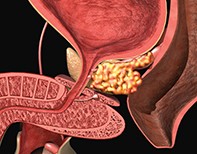Peer Reviewed
Feature Article Men’s health
Prostate cancer: what’s new?
Abstract
Although there is still no recommended prevention policy for prostate cancer, advances are being made in its earlier detection and treatment.
Key Points
- The overall philosophy in prostate cancer screening is to detect significant cancers in those who could benefit from their diagnosis.
- The increased use of active surveillance for patients with low-risk prostate cancer is reducing overtreatment.
- New tests now available are the Prostate Health Index (PHI) and the urinary PCA3 test. The PHI has better sensitivity but not specificity than the PSA test; the PCA3 test offers little over the PSA test.
- Improved imaging with multiparametric MRI shows promise in appropriate detection of prostate cancer as well as localising and ascertaining the nature of tumours.
- Improved surgical and radiotherapeutic options plus focal therapies under investigation are likely to change the way prostate cancer will be managed in the next five to 10 years.
Purchase the PDF version of this article
Already a subscriber? Login here.

